|
GREETINGS FROM OUR SOLAR POWERED OFFICE!
This past winter was relatively mild in our western
Montana valley; it was strange (but fine!) to have so many mornings
without scraping the windshield or thawing frozen water buckets. But the
snowpack is good up in the mountains, so we are hoping for a summer
without too many forest fires.
 In this issue of our newsletter, our main focus is
the need for backup power systems. Power failures are becoming In this issue of our newsletter, our main focus is
the need for backup power systems. Power failures are becoming
more frequent and of greater duration, but running your necessary loads
doesn't need to be terribly complex.
Some folks who have a grid-tie solar power system with no batteries
realize that they are without electricity if the
utility goes down. But now there are battery-based options available to
power essential loads in the face of
unreliable utility power.
~~~~~~~~~~~~~~~
|
| NEWSLETTER INDEX:
~~~~~~~~~~~~~~~
|
|
BACKUP BATTERY POWER SYSTEMS
Backup power doesn’t have to be complicated.
Here’s an example of an independent power system that will run your
(efficient) refrigerator, computer or TV, and a few lights (all 115VAC
loads). The basic components:
- 4—185W Solar Modules / Combiner Enclosure and
Breakers / Surge Protection
- A-frame Roof or Ground Mount / Samlex 2Kw, 12V Sine
Wave Inverter / AC Subpanel/Safety Fuses
- Charge Controller / Eight 6V, 250aH Batteries /
Battery Monitor & Cables
This system totals out right around $4999 before freight,
installation, wire runs, and miscellaneous electrical widgets. This system
will provide approximately ~2200 watt-hours per day for four hours of full
sunlight. You will get more in the summer (and less in the winter),
depending on your location and amount of sun received. The batteries will
provide three days of back-up power at the usage rate of ~2000 watt-hours
per day.
If you think the loads you want to power would exceed
2000 watts (continuous draw), you can go with a larger inverter; we have
found those manufactured by Magnum Energy to be very reliable, as well as
offering 240VAC capacity.
|
|
|
|
Examples of different types of roof/ground
mounts. Many people prefer pole mounts (far right), as they are easy to
seasonally adjust for a better angle to catch the sun’s
rays.
|
|
The batteries specified in the example systems, above,
are flooded lead acid; they are still the best deal but will require
maintenance, and they need to be in a vented battery enclosure. A plywood
box with the top vented with a PVC pipe is quite adequate (vented to the
outside of your garage, shop, or basement), but if you are unable to
maintain your batteries you may need to consider absorbed glass mat (AGM)
or gel-cell batteries. They are more costly and have a shorter cycle life
but require little (virtually no) maintenance except for regular charging.
The correct charge controller for your system depends on the
features you desire and the amperage coming off your solar array; if you
plan to add to your system, it’s a good idea to get the size controller
you need at the onset, saving you money in the long run. |
|
|
|
Pictured left to right, Morningstar's Tristar MPPT60, Midnite
Solar's Classic Controller, and Morningstar's MPPT 15
(12/24V) |
| |
|
Inverters take the DC power from your batteries to
run your regular AC loads; they are generally sized according to two
factors, the continuous amount of power needed and the peak loads
(total watts of the maximum amount of electricity running at one
time). You’ve probably seen the smaller inverters in the 50W to 200W
range, with a DC plug that can run off the 12V supply in your car.
The bigger models can handle whatever loads you need to power, as
long as they do not exceed their current rating. |
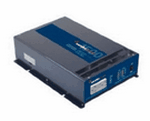 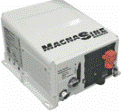
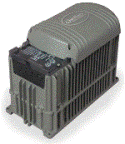
Above: Samlex and Magnum
Energy inverters. Right: Outback Power inverter.
Proper sizing of your inverter is very important, as it's a costly
component to upgrade--so be sure to get the correct size at the
onset.
| |
|
The load sizing is critical in determining which inverter
is best for your project. If it is undersized, it won’t handle the loads
you want to run; and if it is oversized, you will pay more than is
necessary. The Samlex are fine quality, low-cost, smaller inverters with
excellent sine-wave AC power output, but they do not have a built-in
battery charger as do Magnum and Outback. If you plan to integrate a fuel
generator into your back-up system, you will either need a separate
battery charger or an inverter with one that is built in. We have
more on back-up power; visit "Be Prepared for Your Next Power Outage"
below.
~~~~~~~~~~~~~~~
|
|
GAS RANGES, REFRIGERATORS, AND FREEZERS
No power is no problem with non-electric gas
ranges, refrigerators, and freezers. Our Peerless Premier ranges are
available in DC electronic ignition models, in sizes from 20 to 36 inches,
or with AC igniters, in which the burners and oven can be lit with a match
if the power goes out. All these appliances will operate on LP (propane)
or natural gas; some need to be set up for your preference at the factory.
For more information, specifications, pictures, fuel consumption, etc.,
visit http://www.lpappliances.com/.
|
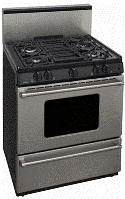
Peerless-Premier Model P30T3102P, 30"
oven |
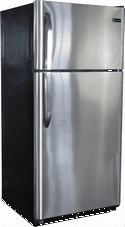
Diamond Stainless 19 cu.ft. Gas
Refrigerator |
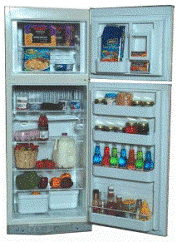
Dometic 8 cu.ft. Capacity Gas
Refrigerator |
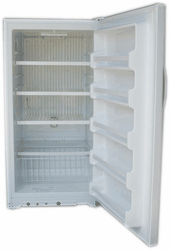
Blizzard 18 cu.ft. Gas
Freezer
(The 18 cu.ft. Blizzard is no longer available
as of 06-09/2014. Blizzard freezers are currently available in
15 and 22 cu.ft. capacities.) | |
|
~~~~~~~~~~~~~~~
SUNDANZER DC
REFRIGERATOR |
|
NOW AVAILABLE: The 15 cu. ft. capacity DC
Refrigerator by SunDanzer! The DCRF450 is designed for the off-grid
homeowner. Thick insulation and a high-efficiency compressor will
provide low energy use and years of reliable operation. $1975 plus
freight.
Specifications:
- Refrigerator capacity: 10 cu.ft.
- Freezer capacity: 5 cu.ft.
- Voltage: 12V or 24V
- Energy used (90° F): 0.95
kWh/day
- PV array size: 250-350W
- Defrost: Manual
- Exterior dimensions: 74.75"H x
30.75"W x 28.5"D
- Shipping weight: 228 lbs.
While some of the refrigerator
components are manufactured in other countries, the compressor and
other parts are made in America, so these are considered to be made
in the USA. Ship from TX.
Sorry, this unit is not available, but SunDanzer does make a
smaller, 4.7 cu. ft. upright refrigerator freezer. For more
information, go to
http://www.eco-fridge.com/Upright-DC-Refrigerators.html.
We also have compact and full upright DC refrigerator-freezers
available from Sun Frost,
http://www.eco-fridge.com/sunfrost.html.
|
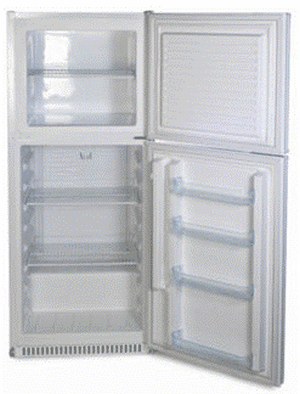
SunDanzer 15 cu.ft. DC-Powered Refrigerator
| |
~~~~~~~~~~~~~~~
ENERGY EFFICIENT
APPLIANCES
|
|
Keep a lid on your electrical usage with efficient
appliances. Many conventional American homes are not designed
for efficiency — but as electrical rates rise, people are learning the
benefits of purchasing efficient appliances to keep a lid on their utility
bills. You can view a variety of appliance data at
http://www.energystar.gov and http://www.aceee.org/; these can be
rather ponderous sites but there’s a lot of information there if you sift
through the links. And our site on AC & DC appliances is http://www.eco-fridge.com/.
~~~~~~~~~~~~~~~
|
|
SOLAR MODULE PRICING
Call for availability, freight costs, and quantities (#
of modules) on pallets for the best deal. You can’t get less than a pallet
quantity to get the pallet ‘deal.’ For larger modules, pallet quantity
generally runs between 20 and 40 modules, and often there are significant
additional charges for less (or more) than even pallet quantities. Some
suppliers charge re-boxing fees, too. (Sorry, but the Helios
modules are no longer available. The company has gone out of
business as of September 2013.)
|
| Module
|
Single/Pallet |
| LG280 Neon 280W, 9.07A, 31.4V
(64.57” X 39.37”) Made in South Korea |
$449 / $427 (27) |
| SANYO HIT 235W, 43.4V. 5.41A
(62.2”X31.4”) Made in the USA, ARRA compliant;
monocrystalline |
$619 (40) |
HELIOS 6T 255, 250W, 30.65V,
8.32A (66.1” x 39”) Made in Milwaukee, USA;
monocrystalline
(These are no longer available as the company has closed shop.) |
$389 / $359 (25) |
| SHARP NU-Q240QCJ, 240W, 29.3V,
8.75A (39.1” x 64.6”) Made in the USA |
$339 / $329 (34) |
SOLARWORLD SW255, 250W, 6.69A,
34.6V (37.4” x 65.9”) Made in the USA or Germany;
monocrystalline |
$430 / $419 (30) |
| CANADIAN SOLAR, 250W, 30.1V,
8.3A (64.5” X 38.7”) Made in China;
polycrystalline |
$329 / $315 (24) |
| EOPLLY 185W, 36.2V, 5.21A (62.2”
x 31.8”)Made in China; monocrystalline |
$299 / $269 (28) |
CONERGY PH250, 250W, 8.27A,
30.3V (65” x 39.1”) Made in Taiwan & Eastern
Europe;
polycrystalline |
$339 / $319 (25) |
SUNIVA 260W, 30.2V, 8.6A (38.66”
x 65.07”) Buy American Compliant—cells made in
the U.S.,
assembled in China |
$379 / $352 (22) |
| KYOCERA 245GX, 245W, 8.23A,
29.8V (64.5” x 39”) |
$399 / $369 (20) |
| KYOCERA 140GX, 140W, 7.91A,
17.7V (59.1” x 26.3”) Made in Japan, Mexico and
San Diego, CA |
$339 / $319 (20) |
| (Some Kyocera modules may have a 2-3
month lead time) |
|
| Kyocera KS20, 20W, 16.9V, 1.20 A
(20.47” X 13.85”) |
$169 / $158 (40+) |
| Kyocera KS10, 10W, 16.9V, 0.60A (11.96”
X 13.85”) |
$113 / $110 (40+) |
| Kyocera KS5, 5W, 16.9V, 0.29A (8.07” X
13.85”) |
$ 84 / $ 74 (40+) | |
|
Other modules are available too—Samsung, Yingli, GES,
Trina, Hanwha, Alps, Solartech, Sunwize, BP; prices are subject to change
with little notice—often for the better. Call for your module pricing and
availability. Container pricing available for better dollar-per-watt
cost.
~~~~~~~~~~~~~~~
|
AC SOLAR MODULES
|
 This is a very slick and easy product for folks who want a
grid-tie system, small or large. The Eoplly AC modules have a Solar
Bridge Technologies 240W Inverter factory-connected to the Eoplly
module frame. Each module is interconnected to others in the string
via Eoplly-supplied AC accessory cables, making a truly AC solar
module. A variety of mounting options are available; strings are
limited to 16 and arrays to 100kW per Power Monitor. Larger arrays
can be developed; call us for more information. This is a very slick and easy product for folks who want a
grid-tie system, small or large. The Eoplly AC modules have a Solar
Bridge Technologies 240W Inverter factory-connected to the Eoplly
module frame. Each module is interconnected to others in the string
via Eoplly-supplied AC accessory cables, making a truly AC solar
module. A variety of mounting options are available; strings are
limited to 16 and arrays to 100kW per Power Monitor. Larger arrays
can be developed; call us for more information.
AC modules
generally outperform string inverter-based systems if there is any
shading at all, including residual snow at the bottom row of cells.
Virtually any shading of the array in string inverter systems is cause for power loss.
cause for power loss.
These are available in pallets of 18
for $9288 plus freight (more or less will involve a 'pallet
breaking' fee of $100); with a 25-year power warranty on the solar
module and a 25-year warranty on the AC output for the inverters,
this combination is hard to beat! There's also a mobile device
application available so you can monitor the system's performance on
a web-based portal.Features include:
 Up to 25% more energy than central inverters. Up to 25% more energy than central inverters.
- Reduced shading, clouds, multi-roof issues.
- 238W AC power output.
- No separate grounding or DC wires.
- Deflection of high-voltage arcing and reduction of fire risk.
- Only AC wiring, resulting in safer installation.
- Nominal voltage--240VAC, 60 hertz.
Call us at 406-777-4321 for more information on this exciting
development!
~~~~~~~~~~~~~~~
| |
|
WHO WE ARE and ORDERING
INFORMATION: Chris Daum, owner
and manager of Oasis Montana, has been in the renewable energy field for
24 years, and our system designers will help plan a system for your needs. Our
staff offers experience, personalized service, tech support, quality
components, and good pricing. We are happy to work with your installer,
electrician, or contractor, and locally we can install your power system
(or even fly to your site for installation). We provide detailed wiring
diagrams with the systems we sell. TO PLACE AN ORDER: Email or call
us for your freight costs; if you have any questions about your system or
product, please contact us. Email is easiest and fastest (but we know that
you aren’t all online). We accept Visa/MasterCard (personal and business
checks are fine). For our international customers, we accept bank
transfers— email or call us for our banking information. Our summer hours
(April through October) are 8:00 am to 4:30 pm Mountain Time, Mon. –
Thurs, 8 to 4 on Fridays. If we‘re on another line when you call, please
leave us a message and we’ll get back to you as soon as we can, but you
may have to leave a message if we’re with a customer or on one of the
other lines. Call 406-777-4321 or 4309 or email us at info@oasismontana.com. For
tech support on renewable energy systems, again, email us at
info@oasismontana.com.
We’d be very happy to help you with your power project — send an email or
give us a call!
~~~~~~~~~~~~~~~
|
|
POWER OUTAGE SOLUTIONS
Are you ready for your next power outage? With the advent
of superstorms such as Hurricane Sandy, floods, unpredictable tornadoes,
or simply because of aging utility infrastructure, Americans are dealing
more and more with undependable utility (grid) power. We at Oasis Montana
have been designing backup power systems for whatever loads you need to
run; we can make these systems seamless so you do not know the power’s
even gone out, or, you can plug in your specific loads as needed at the
time of a power outage. Recent power outages show people the tremendous
value of backup systems, and there are many different solutions to utilize
inverters for backup capability. Connecting backup loads can be very
simple or complex. And, the amount of time provided for backup power
depends on the loads you want to run and your battery
capacity.
|
|
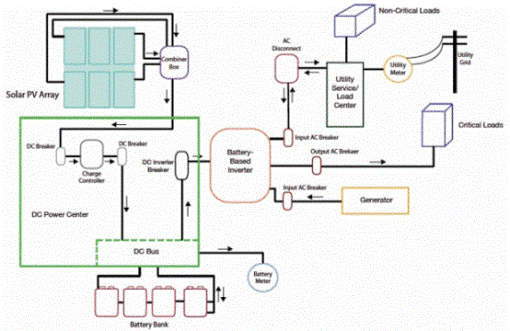
During a power outage, an auto-transfer
switch in the inverter opens the grid-interconnect, which isolates
the building from the utility to prevent any back-feeding into the
local power lines. Then the inverter draws from the batteries to
provide AC power to the subpanel. If you are starting from scratch,
a DC coupled system is likely to be the most cost-effective and
reliable configuration to use.
|
The diagram at left is an example of a
D- coupled PV system; the solar (PV) array’s power goes through the
charge controller to charge the battery bank. When the batteries are
fully charged, power is fed back through the inverter for use. The
inverter output is connected to the backup (i.e. critical load)
subpanel, as well as grid-intertied to the main electrical panel.
Under normal conditions, it functions like any net-metered
inverter.
 | |
|
In an “AC coupled system (right), a
batteryless, grid-tie inverter is connected to the solar array,
while a battery-based inverter is used to power loads from the
battery bank in the event of a utility outage. In this scenario, the
AC output of the grid-tie inverter is connected to the backup
(critical load) subpanel rather than the building main electrical
panel.
The backup subpanel is also connected to the AC
output of the battery inverter; the AC input of the battery inverter
is then connected to the main panel as in a DC-coupled
system.
Under normal conditions, the batteryless grid-tie
inverter is passed through the battery-based inverter’s built-in
transfer switch to the main panel and utility inertia, without loss
of efficiency.
|
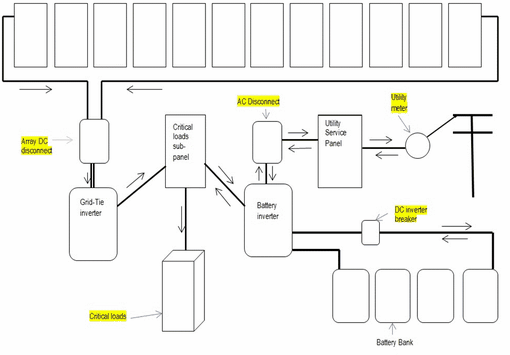 | |
|
Likewise, grid power can pass the other direction when
needed to power the loads in the backup subpanel. During a power outage,
the battery inverter’s transfer switch isolates itself from the utility
connection and provides AC power to the backup subpanel, drawing energy
from the battery bank. The batteryless grid-tie inverter will shut down at
the start of a blackout, but will turn back on (after a mandatory 5-minute
waiting period) when AC power from the battery inverter is detected,
supplying AC power to the backup subpanel. If enough power is available it
will be used by the battery inverter to charge the batteries. Note that
once the battery bank is fully charged and the loads are served, the
batteryless grid-tie inverter will need to be throttled back, diverted, or
shut down in order to prevent damage to the batteries, so you may need a
diversion regulator (or ‘dump load’) on the battery bank.
An
AC-coupled system offers a few advantages compared to the traditional
DC-coupled system. The batteryless grid-tie inverter can use the higher
voltage from the solar array, reducing the required wire size, and is
generally more efficient than a battery-based inverter. Additionally, if a
direct grid-tie system is already installed and battery backup is added
later, it is often more convenient and cost-effective to leave the
existing system in place. A disadvantage, though, is that AC-coupled
systems are typically much more expensive and complex to design, and only
certain inverters can be used in such systems. But, the battery-based
inverter can, with this type of system, be added to an existing grid-tie
system to provide necessary backup power in the event of a power outage,
resulting in money savings on your utility bill when the grid is up, and
to run whatever you need to when the power goes out.
At present
the SMA Sunny Island is the only equipment specifically made to be
AC-coupled (with SMA Sunny Boy grid-tie inverters) and is fully factory
supported. With the exception of high-frequency inverters, such as Fronius
IG Plus and SMA SunnyBoy HF, most batteryless grid-tie inverters could be
made to work in an AC-coupled mode...but, most manufacturers cannot
provide adequate tech support, and some warranties will become void if the
inverter is AC coupled. OutBack Power and Magnum Energy make battery-based
inverters that can be used in an AC-coupled configuration.
It is,
of course, possible to have a battery backup system that is entirely
separate from a solar grid-tied system (like our example system on page
1). In parts of the world with frequent short outages, many people just
install a battery based inverter and battery bank without any PV
whatsoever. Very similar to a UPS (uninterrupted power system), the
battery is kept charged by the inverter from the utility AC power as long
as the power is on, and during a power outage will supply power from the
battery to AC loads. This type of system has no way of being recharged
during an outage, (unless you have a fuel generator or add photovoltaic
modules) so the amount of electricity provided cannot exceed your storage
capacity. Of course, adding PV power to this sort of system makes it just
like one of our basic remote power systems; simple since no grid-tie is
necessary.
The common method of connecting backup loads is with a
subpanel that serves specific circuits. The backup subpanel (could be a
6-breaker Square D box) is typically installed next to the main panel so
that the circuit wiring can be easily transferred from the main panel to
the subpanel. These circuits are then automatically powered through the
backup system during a utility outage. Only complete circuits can be wired
this way, not individual appliances. Appliances can occasionally be moved
from other circuits onto a backed-up circuit or loads can be turned off of
backed-up circuits if they are not needed during an outage. And, you may
want to disconnect certain unnecessary large loads if they are on these
circuits, to prolong your battery backup. If it helpful for the end user,
unique styles or colors of receptacles can be installed on backed-up
circuits. It is possible to have a backup system power an entire home or
building if either the backup system is very large or the loads are
efficient and unusually low. This is not often done because it requires a
backup system large enough to power all loads in the house. Otherwise, the
loads running when the outage occurs may overload the inverter (or drain
your batteries quickly), defeating the backup system’s purpose.
For a grid-tied battery-based system, such as the one here in our
office, the sizing of the solar array is much the same as for a
non-battery grid-tie system. The limitations on the solar array are still:
space for installation, maximum offset of utility power, and budget. Often
a solar array sized for grid-tie will be more than large enough during a
power outage. For AC-coupled systems, the battery-based inverter typically
needs to be larger than the batteryless grid-tie inverter for best
results, since it must be able to power your continuous loads.
The
battery bank size is determined by the length of time and the size of the
loads to be run during an outage. Backup systems can be made to supply
power for minutes, hours, or days. If outages are brief or if a backup
generator is planned, the battery bank only needs to be large enough to
carry the loads for a few hours. Most often, a backup time of a half day
or multiple days is desired. If there is not much sun, a generator can be
run for a few hours per day to keep the battery bank charged. If the
system is to be capable of running indefinitely, it should be sized like a
true off-grid system.
As to batteries needed, the best bang for
the buck is still the flooded lead acid cells, but these require regular
maintenance and a battery box designed to safely outgas its fumes. If your
storage needs are not too great we would likely recommend AGM (absorbed
glass mat) batteries, which are non-spillable and require little
maintenance. (Diagrams and part of article source: Brad Bassett of AEE
Solar).
For more information call us (406-777-4309 or 4321), or you
can also visit http://www.sma-america.com/en_US.html,
http://www.outbackpower.com/,
or http://www.magnumenergy.com/
for information about these inverters.
|
|
~~~~~~~~~~~~~~~
|
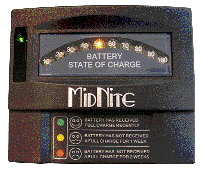
Midnight Solar Battery Capacity
Meter $69 |
BATTERY CAPACITY METER from Midnite Solar:
These smart people have come up with a very simple and
cost-effective way of keeping track of your batteries' condition. If
you are serious about having back-up power, you NEED to know your
batteries’ state of charge. Not having a meter on your batteries is
a lot like driving a car with no gas gauge! The Battery Meter can be
used with all types of lead-acid batteries and will automatically
detect the voltage of the battery bank, but for the most accurate
readings you should set the meter for the type of battery being
monitored (gel, AGM, or flooded). You select the battery type by the
placement of a small jumper on the circuit board pins, and battery
voltage of 12V, 24V, 36V, and 48V is automatically selected.
These meters are intended for indoor use only and must be
protected from moisture and direct sun. Installation instructions
are clear and easy to follow. While there are other meters available
that offer more detailed information, at only $69 this one is hard
to beat!
| |
|
~~~~~~~~~~~~~~~
|
|
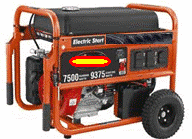 Do you have a
fuel generator for backup power? If you’ve had any
significant power outages lasting more than a few hours, you know
you need to keep a substantial fuel tank available. Many people,
whether for remote homes or for emergency backup, have found that
the addition of an inverter and battery bank will significantly
reduce the generator run time and save fuel. Most folks who have
generators only use a fraction of their output at any given time.
They'll be sucking down a half gallon an hour (or more) just to
power some lights, and maybe a microwave or fridge for a while,
leaving most of that capacity wasted. They'll go through 10-15
gallons a day to do very little work (there are some generators that
are better at throttling output to closely meet demand, but most
home generators out there don't). When you have a battery/inverter
system, you can fire up the generator, run it at full capacity for
an hour or two, then shut off the generator and run your AC loads as
needed since you are charging the battery bank via your inverter's
charger while your generator is running. You can make your fuel
resource last much longer. It is important that you size the
inverter so it will be able to handle the continuous power
requirements, as well as the starting surge, of any loads you wish
to run. In the average home this might be a water pump and a washing
machine, since those are two sizable loads that are apt to be
running at the same time. Do you have a
fuel generator for backup power? If you’ve had any
significant power outages lasting more than a few hours, you know
you need to keep a substantial fuel tank available. Many people,
whether for remote homes or for emergency backup, have found that
the addition of an inverter and battery bank will significantly
reduce the generator run time and save fuel. Most folks who have
generators only use a fraction of their output at any given time.
They'll be sucking down a half gallon an hour (or more) just to
power some lights, and maybe a microwave or fridge for a while,
leaving most of that capacity wasted. They'll go through 10-15
gallons a day to do very little work (there are some generators that
are better at throttling output to closely meet demand, but most
home generators out there don't). When you have a battery/inverter
system, you can fire up the generator, run it at full capacity for
an hour or two, then shut off the generator and run your AC loads as
needed since you are charging the battery bank via your inverter's
charger while your generator is running. You can make your fuel
resource last much longer. It is important that you size the
inverter so it will be able to handle the continuous power
requirements, as well as the starting surge, of any loads you wish
to run. In the average home this might be a water pump and a washing
machine, since those are two sizable loads that are apt to be
running at the same time.
We don’t sell generators but do
know how to specify the proper inverter for your project, as well as
what generator features to have (a 2-wire electric start is a real
good idea). We can make these systems turn-key enough that when your
battery voltage drops (from running your AC loads), your inverter
senses the voltage drop and turns on your generator; once the
batteries are ‘fat,' the inverter turns off your generator, saving
fuel. Questions? Give us a call at 406-777-4321.
|
|
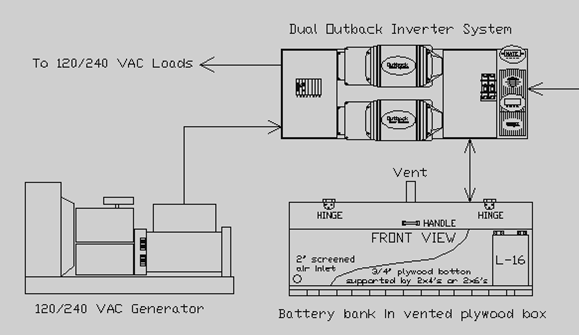
Basic diagram of a gen/verter
system

|
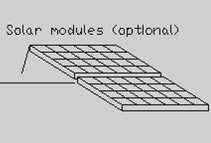
SUPER
OUTAGE
The
power outage that halted Super Bowl XLVII was caused by an
electrical relay installed to prevent a power failure, according to
the company that supplies power to the Superdome. “The purpose of it
was to provide advanced protection,” according to Entergy Corp.
executive Dennis Dawsey. The relay was part of an upgrade to the
Superdome’s electrical system undertaken in 2011 in anticipation of
the championship game.
OOPS!
| |
|
~~~~~~~~~~~~~~~ |
|
You too can have hot water on
demand—even with a standard electric water heater—and save on your
electric bill at the same time. One of the ways to
increase the efficiency of your water heater is to turn it off when
not in use. This option may not work for every household, but if
your family tends to take showers or do laundry on a more-or-less
regular basis, or the same time every day, you can really reduce the
electricity used by installing a general duty 30A safety switch.
These are readily available at your local hardware store; while it
is not difficult to install, you will probably want to hire a
professional to do it safely and properly.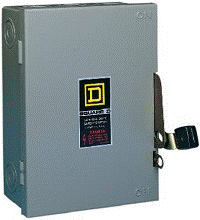
My husband installed one here at our home/office, and we turn it on
about
15 to 30 minutes before we take our showers (or do laundry). After
showering, we turn it off again until the next time it’s needed. Why
keep a
pair of 1500W or 1800W heating elements on, 24 hours a day, when you
might really only need it for 30 to 45 minutes?
This may not
suit you if you have a big family or are constantly needing hot
water, but I am always pleased at just how long the water stays hot
after
we’ve turned it off—we still can do dishes or laundry at least 12
hours after
it’s been shut down.
You can also extend your availability of hot water by
purchasing an insulative blanket for
your hot water heater—these are also commonly available at your
hardware store.
Since we’ve installed our grid-tie system at
Oasis Montana, we’ve been trying new things to continue to reduce
our electrical use—like this disconnect switch and using LED
lighting. At present, we have not been buying any electricity from
Northwestern Energy for about 9 months out of the year...but I still
don’t know how to offset the heat lamps I put on my chickens when it
gets cold….
| |
|
~~~~~~~~~~~~~~~
|
|

Quinoa, amaranth and sunflowers in last
year’s Oasis garden.
GARDEN FOR
VICTORY!
|

Chris Daum, Owner of Oasis Montana, and pet
chickens.
My husband thinks it’s funny that
I actually grow foodstuffs for the chickens. But doing that cuts
into my feed bill, keeps them much healthier, and contributes to my
enjoyment of them by providing them ‘treats.’ This year I have
multi-colored corn and red amaranth seed to give away; send me a
self addressed envelope or a couple of stamps and I will happily
send some seeds your
way.
| |
|
~~~~~~~~~~~~~~~
|
|
Solar power system owners reap the
benefits of tax credits There
are still tax credits for these kinds of systems, (they’re not going to be
‘sequestered,’ thank goodness!), and your state or utility may also offer
additional incentives. The ITC (Investment Tax Credit) allows power system
owners to take a 30% federal tax credit of the qualifying costs of the
solar electric system. Now, the ITC can only be taken in the tax year the
system was placed in service; if you installed a system in 2012, you
should use IRS Form 3648 to take the tax credit for 2012. The ITC is not
refundable; if the 30% credit exceeds your federal tax liability, it can
be applied to next year’s taxes. The ITC is for system owners — if you are
leasing or financing your system, that system is not eligible for the ITC.
In most cases, any other state incentives or grants must be
subtracted from the system’s cost before calculating the tax credit. It’s
wise to speak to your accountant to determine if this applies to your
specific situation. And if you have a commercial system, there may be
additional federal tax benefits; some commercial solar owners can benefit
from 50% 'bonus' depreciation, which allows for the deduction of 50% of
the depreciable basis of a solar electric system in the first year of
operation. This benefit is available for commercial solar electric systems
placed in service in 2012 and 2013.
Many states also offer
incentives which can reduce your tax liability — and all of these make
solar power more affordable. You can find out what incentives are
available for you at http://www.dsireusa.org/ (a
state-by-state database that is updated regularly).
For solar
water pumping systems, at this time, you can only get the ITC on the
solar components, NOT on the pumping goods...
|
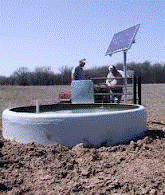 |
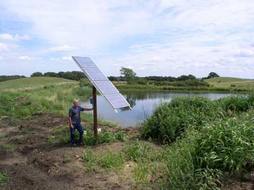 |
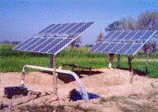
Stock watering and irrigation
systems are becoming more affordable and reliable.
|
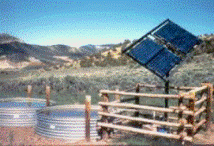 |
|
But there are other grant possibilities for
solar pumping projects; Visit http://www.rurdev.usda.gov/BCP_Reap.html
for more information (or contact your local USDA or NRCS office for
information about their REAP programs). The drought that devastated
so much of the U.S. last year has spurred programs and financial
assistance for eligible landowners and agricultural producers for
irrigation, conservation and stock watering. NOTE that
Rural Energy for America Program (REAP) grant applications must be
submitted before May 31, 2013 (recently extended from April 30).
|
|
There are also wildlife oriented programs
through which the agency approves contracts to provide financial
assistance to help plan and implement conservation practices that
address natural resource concerns or opportunities to help save
energy, improve soil, water, plant, air, animal, and related
resources on agricultural lands and non-industrial private forest
land.
Visit http://www.nrcs.usda.gov/wps/portal/nrcs/main/national/programs/financial/
for additional information.
If you are thinking about a
solar water pumping project, visit http://www.pvsolarpumps.com/;
once we have the answers to the questionnaire, we can propose a
system for you. Or call for more information, 406-777-4321.
|
|
~~~~~~~~~~~~~~~
| |
|
RENEWABLE ENERGY
NEWS BITES:
Biofuels making the news. Turning ‘yuk’ into
‘ka-ching’ — and aviation fuel and bio-diesel. Read more at http://www.biofuelsdigest.com/bdigest/2012/12/04/the-beverly-landfillies-new-technologies-turning-yuk-to-ka-ching/
New Research Shows Climate Emissions from Keystone XL Tar Sands
Pipeline Much Worse Than Reported: http://www.nrdc.org/media/2013/130117.asp.
Cyber
attack on electrical grid almost certain: http://www.fiercehomelandsecurity.com/story/mit-cyber-attack-electric-grid-almost-certain/2011-12-05?utm_medium=nl&utm_source=internal.
This
robot eats Sewage: http://phys.org/news/2012-11-ecobotiii-sewage-powered-robot.html.
Solar
is Cheaper Than Coal in New Mexico: Although new solar plants can't
yet compete on price with legacy coal plants, they are nearing the point
where their economics look better than those for new coal plants. That's
happening in New Mexico, where First Solar plans to sell solar electricity
from its new 50-megawatt Macho Springs project to El Paso Electric Co. at
5.79 cents per kilowatt-hour. That's less than half the 12.8 cents per kWh
that new coal plants typically charge. http://www.sustainablebusiness.com/index.cfm/go/news.display/id/24550.
Robert
Newman’s History of Oil: A little long but good-humored and very
interesting: http://www.youtube.com/watch?v=sehmmzbi3UI.
Combating
climate change makes economic sense: The Hewlett Foundation recently
sponsored a study of the economic consequences of these policies over the
past three decades. It tells an amazing story. California now uses half as
much energy per capita as the nation as a whole, saving the average
household $1,000 each year, with total savings now more than $56 billion.
New York households have similarly benefited. Whereas per-capita
electricity use across the nation has increased 50 percent in the last 30
years, in New York it has risen only 15 percent, due to the state's focus
on energy conservation, saving billions of dollars. The bottom line here
is that saving energy is not only good for the environment, it also saves
people money. http://www.sfgate.com/opinion/openforum/article/Combating-global-warming-makes-economic-sense-2503537.php.
Netherlands
is combating rising oceans by building floating homes: http://www.bbc.co.uk/news/world-europe-21180779.
Coal
Plants Are Victims of Their Own Economics: Plans for more than 150 new
coal-fired power plants have been canceled since the mid-2000s, existing
plants have been closed, and in 2012, just one new coal-fired power plant
went online in the United States. http://news.sciencemag.org/sciencenow/2013/02/coal-plants-are-victims-of-their.html?ref=hp.
According to a detailed analysis of coal plant finances and economics by
the Institute for Energy Economics and Financial Analysis, coal is losing
its battle with other power sources mostly on its merits. Over the past 6
years coal's share of U.S. electrical generation has fallen from 50% to
38%. There are several reasons for coal’s decline. Over the past decade,
construction costs have risen sharply. In addition, since the mid-2000s,
the price of natural gas has plummeted. Coal is also struggling because
many power plants that burn it are aging to the point that more parts
break and they’re becoming expensive to maintain. Sixty percent of the
nation’s coal plants are more than 40 years old, and the median age of
coal plants retired in 2012 was 53 years.
Who's paying for
fracking technologies? Taxpayers: www.fosters.com/apps/pbcs.dll/article?AID=/20120930/GJBUSINESS_01/709309976/-1/FOSBUSINESS.
Report
Says Global Fossil Fuel Subsidies Dwarf Renewables Aid: The production
and consumption of fossil fuels add costs to society in the form of
detrimental impacts on resource availability, environment, and human
health. The U.S. National Academy of Sciences estimates that fossil fuel
subsidies cost the United States $120 billion in pollution and related
health care costs annually. But these costs aren’t reflected in fossil
fuel prices. http://www.worldwatch.org/fossil-fuel-and-renewable-energy-subsidies-rise-0.
Notes on ideal civilization (good comments too): http://2greenenergy.com/ideal-civilization/34307/#comments.
China, coal-fired power plants and ecological disaster: http://2greenenergy.com/china-coal-fired-power-plants/33953/#comments.
Whom
do you trust - science or fossil fuel lobby? http://2greenenergy.com/scientists-warn-of-climate-disaster-but-are-they-to-be-trusted/33665/#more-33665.
Solar
cheaper than nukes: http://cleantechnica.com/2013/02/19/solar-power-cheaper-than-nuclear-in-cloudy-old-england/.
|
|
~~~~~~~~~~~~~~~
|
|
QUOTABLE
QUOTES:
“Live as if you were to die tomorrow.
Learn as if you were to live forever.” - - Mahatma Gandhi
"If we've
learned any lessons during the past few decades, perhaps the most
important is that the preservation of our environment is not a partisan
challenge, it's common sense." - - Ronald Reagan
“Anyone who stops
learning is old, whether at twenty or eighty. Anyone who keeps learning
stays young. The greatest thing in life is to keep your mind young.” - -
Henry Ford
“It is better to remain silent and be thought a fool
than to open one’s mouth and remove all doubt.” - - Mark Twain
“The only thing that could spoil a day was people. People were
always the limiters of happiness except for the very few that were as good
as spring itself.” - - Ernest Hemingway
"Now every field is
clothed with grass, and every tree with leaves; the woods put forth their
blossoms, and the year assumes its gay attire." -Virgil
“Educate
your children to self-control, to the habit of holding passion and
prejudice and evil tendencies subject to an upright and reasoning will,
and you have done much to abolish misery from their future and crimes from
society.” - - Benjamin Franklin
"As I hurtled through space, one
thought kept crossing my mind - every part of this rocket was supplied by
the lowest bidder." - - John Glenn
"All through the long winter, I
dream of my garden. On the first day of spring, I dig my fingers deep into
the soft earth. I can feel its energy, and my spirits soar." - - Helen
Hayes
"If you've never been thrilled to the edges of your soul by
a flower in spring bloom, maybe your soul has never been in bloom." - -
Audra Foveo
“I’ve been imitated so well I’ve heard people copy my
mistakes.” - - Jimi Hendrix
“It is well enough that people of the
nation do not understand our banking and monetary system, for if they did,
I believe there would be a revolution before tomorrow morning.” - - Henry
Ford
"Spring makes its own statement, so loud and clear that the
gardener seems to be only one of the instruments, not the composer." - -
Geoffrey B. Charlesworth
|
|
~~~~~~~~~~~~~~~
|
|
Thank you for your
interest in Oasis Montana. For more information go to http://www.oasismontana.com/, send
us an email at info@oasismontana.com, or call us
at 406-777-4321or 4309.
And feel free to share this newsletter with your friends; knowledge is
POWER!
| |
